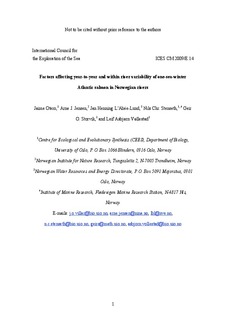Factors affecting year-to-year and within river variability of one-sea-winter Atlantic salmon in Norwegian rivers
Otero, Jaime; Jensen, Arne J.; L’Abée-Lund, Jan Henning; Stenseth, Nils Christian; Storvik, Geir; Vøllestad, Leif Asbjørn
Working paper

Åpne
Permanent lenke
http://hdl.handle.net/11250/102890Utgivelsesdato
2009Metadata
Vis full innførselSamlinger
Originalversjon
This report is not to be quoted without prior consultation with the General Secretary.Sammendrag
Many Atlantic salmon, Salmo salar, populations are decreasing throughout its
distributional range due to several factors acting in concert. A number of studies have
documented the influence of freshwater and ocean conditions, climate variability and
“man-made obstacles” including dams and aquaculture. However, most of the historical
research has focused on single or few river analyses, and quantifying isolated effects
rather than handling factors in conjunction. By using a multi-river mixed-effects model
we estimated impacts of oceanic and riverine conditions, as well as human threats on
both year-to-year and within river variability across 60 time series of recreational catch
of one-sea-winter salmon (grilse) from Norwegian rivers over 29 years (1979-2007).
Warm coastal temperatures at the time of smolt entrance into the sea and increased
water discharge during upstream migration were associated with higher rod catches of
grilse. When hydropower stations are present in the course of the river systems the
strength of the relationship with runoff is reduced. Moreover, catches of grilse in the
river increased significantly following the discontinuation of the harvesting of this lifestage
at sea. However, a general decreasing temporal trend was still detected being
stronger with the presence of salmon farms in the migration route of smolts in
coastal/fjord areas. These results suggest that both ocean and freshwater conditions in
conjunction with diverse human impacts contribute to shape interannual fluctuations
and within river variability of wild Atlantic salmon.